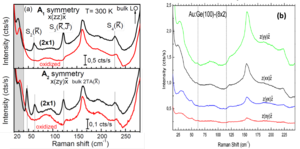P6
Electronic and vibration excitations of ordered adatom assemblies, studied by optical spectroscopy and electron scattering

J. Geurts and F. Reinert
Self-organized ordered sub-monolayer assemblies of metal adatoms (e.g. Au, Sn, Pb) on semiconductor surfaces (Si, Ge) give rise to numerous manifestations of electron correlation effects, such as Mott-Hubbard insulator behavior, charge density waves and Tomonaga-Luttinger liquid physics. For these systems a wealth of experimental and theoretical information is available, which predominantly covers their ground state behavior. Their excitations have been studied far less intensively.
The goal of this project is the experimental investigation of the electronic and vibrational excitations in this class of material systems. The electronic excitation studies aim at the gap energies of surface-orbital bands and the interband transition probabilities, as well as the plasmon dispersion of metallic systems. The vibrational excitations are explored with regard to the eigenfrequencies of the phonon modes and their symmetry and displacement patterns.
The merit of these studies is twofold. First, the knowledge of electronic and vibrational excitation characteristics, such as e.g. correlation-induced gap energies or soft-phonon behavior, is essential for a full understanding of the correlation physics.
Moreover, it should be noted that the excitations provide essential information on the atomic and orbital configuration of the underlying ground state, which is for many systems not yet fully understood. The various vibration modes offer an orbital-selective access to the bond strengths and also reflect the atomic structure. Due to its orbital selectivity and because of the surface-phonon penetration depth of a few atomic layers, this excitation-derived ground state information is complementary to STM and LEED. Thus, it constitutes a vital component for completing the picture of the ground state configuration.
Experimental access to the electronic excitations is achieved by Electron Energy Loss Spectroscopy (EELS) and optically by Reflection Anisotropy Spectroscopy (RAS). The vibrational excitations are tackled primarily by inelastic light scattering (Raman Spectroscopy). Since the emergence of electron correlation is fundamentally connected with the lateral correlation length of the structural ordering, this aspect will be investigated quantitatively by Low-Energy Electron Diffraction with Spot Profile Analysis (SPA-LEED).
The material systems in our focus are the one-dimensional (1D) systems Au/Ge(001) and Au/Si(111) (5x2), and the two-dimensional (2D) (sqrt(3)xsqrt(3)) assemblies of Sn and Pb on Si(111) and Ge(111).
An essential aspect of Au/Ge(001) c(8x2) and Au/Si(111) (5x2) is the atomic structure of the complex chains.
Relevant phenomena in the 2D systems are the order / disorder transitions within the adatom assemblies of Sn or Pb. Beside the temperature-induced Mott-Hubbard transitions, for Sn/Si(111) also the vibration impact of the disputed phase transition from the (sqrt(3)xsqrt(3))-reconstruction to (3x3) is highly interesting.

